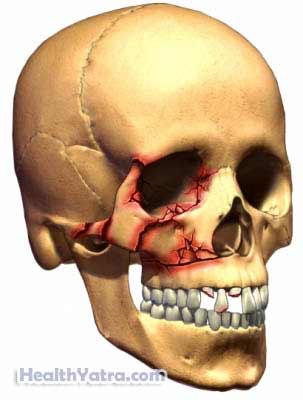تعريف
Skull and facial fractures are broken bones of the head and face.
There are two major types of skull fractures:
- Open skull fracture—part of the scalp is torn
- Closed skull fracture—the scalp is intact
Facial fractures can occur in any of the face’s bones. This includes:
- Maxillary fracture—upper jaw area
- Le Fort fracture—fracture of the upper jaw area and other facial structure, like nasal and oral cavities and orbits (classified I-V depending on the specific bones involved)
- Mandible fracture—lower jaw fracture
- Zygomatic fracture—cheekbone fracture
These fractures are potentially life-threatening conditions. They require immediate medical treatment.

أسباب
Skull and/or facial fractures are caused by injuries. Most commonly from:
- Car accident
- Sports injury
- Domestic violence, child or elder abuse
- Blunt trauma
- Fall
- Gunshot
عوامل الخطر
This type of fracture occurs most often in accidents.
الأعراض
These will depend on the location and extent of the injury. Your doctor will look for the following:
- Signs of injury to the brain:
- Leaking cerebrospinal fluid
- Increased pressure in the brain
- Blood in the ears
- Paralysis to the limbs
- Signs of concussion:
- Dizziness, headache, nausea, feeling faint, changes in vision, grogginess, difficulty concentrating
- Other signs typical of skull and face fracture:
- الألم
- Inability to move face or mouth
- Bruising to eyes and/or face
- Swelling, tenderness at injury site
- الصداع
- فقدان السمع
- Facial fractures can affect the airway and the ability to breath
التشخيص
You will most likely be taken to a hospital. A doctor will ask about your symptoms and how your injury occurred. A physical exam will be done. A neurological exam will evaluate your nervous system. Tests may include the following:
- Glasgow coma scale—neurological exam that tests different parts of the nervous system including:
- Level of consciousness
- Pupil reaction to light
- Reflexes
- Response to stimuli
- CT scan —type of x-ray that uses a computer to make pictures of any fractures or any other injuries to the head
- Examination of ears and nose for fluid—cerebrospinal fluid leaks from ears or nose when there is a brain injury
- Pain assessment
العلاج
Treatment will depend on the location and extent of the injury. Call 911 if you have a head injury.
The first steps will be focused on stabilizing your injury. It may include:
- Attaching a backboard to stabilize the spine (neck especially, as it is often injured along with the face or skull)
- Intravenous fluids
- Oxygen, a breathing tube for a blocked airway
- Admission to the hospital for monitoring
تشمل خيارات العلاج ما يلي:
جراحة
Surgery for this type of injury will depend on the type of injury. It may include drilling burr holes in the skull to release pressure or fixing the broken bones surgically.
If the jaw is broken it may need to be wired.
If there is a collection of blood in the brain, called a hematoma, it may need to be removed. Surgery may take place right away or later once swelling has subsided.
الأدوية
- Medicine may be given to reduce pressure inside the head or brain swelling
- An antibiotic may be given to prevent infection if there is an opening in the scalp
- Medication that prevents seizures is sometimes given
- Pain medicine and sedatives also may be given
العلاج في المستشفيات
People with these fractures usually need to stay in the hospital. Serious injuries may need to be watched in an intensive care unit. Some people with facial or skull fractures need to have help breathing. A tube is inserted and mechanical ventilation is used to protect and assist breathing.
الوقاية
To help reduce your chance of fracturing your skull or face, take the following steps:
- Drive safely and always use a seat belt.
- Do not drive under the influence of alcohol or drugs.
- Avoid situations that put you at risk of physical harm.
- Always wear a helmet when riding a bike or motorcycle.
- Take steps to avoid falls in the home.
- Buckle children into appropriate child safety seats.
